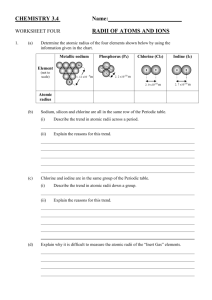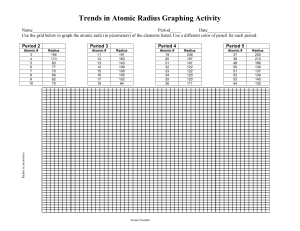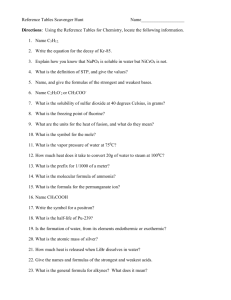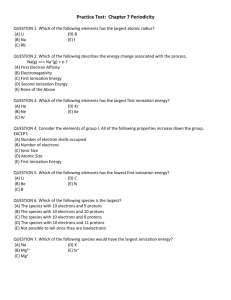Periodic Trends in Atomic Radius
advertisement
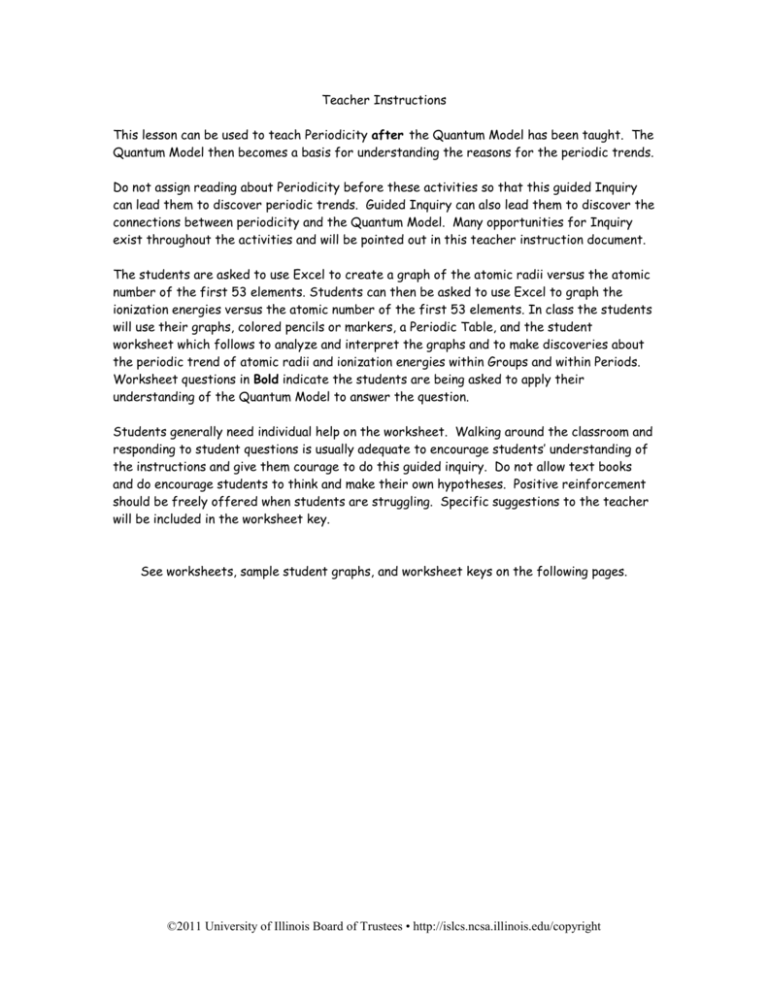
Teacher Instructions This lesson can be used to teach Periodicity after the Quantum Model has been taught. The Quantum Model then becomes a basis for understanding the reasons for the periodic trends. Do not assign reading about Periodicity before these activities so that this guided Inquiry can lead them to discover periodic trends. Guided Inquiry can also lead them to discover the connections between periodicity and the Quantum Model. Many opportunities for Inquiry exist throughout the activities and will be pointed out in this teacher instruction document. The students are asked to use Excel to create a graph of the atomic radii versus the atomic number of the first 53 elements. Students can then be asked to use Excel to graph the ionization energies versus the atomic number of the first 53 elements. In class the students will use their graphs, colored pencils or markers, a Periodic Table, and the student worksheet which follows to analyze and interpret the graphs and to make discoveries about the periodic trend of atomic radii and ionization energies within Groups and within Periods. Worksheet questions in Bold indicate the students are being asked to apply their understanding of the Quantum Model to answer the question. Students generally need individual help on the worksheet. Walking around the classroom and responding to student questions is usually adequate to encourage students’ understanding of the instructions and give them courage to do this guided inquiry. Do not allow text books and do encourage students to think and make their own hypotheses. Positive reinforcement should be freely offered when students are struggling. Specific suggestions to the teacher will be included in the worksheet key. See worksheets, sample student graphs, and worksheet keys on the following pages. ©2011 University of Illinois Board of Trustees • http://islcs.ncsa.illinois.edu/copyright ANALYSIS OF PERIODIC PROPERTIES 1. Using a highlighter, color each of the points on each of the graphs that represent each element in Group 1. 2. Using a different colored highlighter, color the points on each graph that represent each element in Group 18. 3. Using a highlighter, enclose in a circle the points on each of the graphs that represent each element in Period 1. 4. Using a different colored highlighter, enclose in a circle the points on each graph that represent each Period. 5. Look up the dictionary meaning of the word trend. Write it here. Graph of Atomic Radii: 6. What trend do you see of the atomic radii within Group 1? 7. What trend do you see of the atomic radii within Group 18? 8. Examine trends of atomic radii in each of the Groups on your graph. Make a statement that generalizes what happens to the atomic radii within a Group. 9. Make a hypothesis to explain the cause of the trend within Groups. 10. Test your hypothesis and give data that supports/contradicts your hypothesis. ©2011 University of Illinois Board of Trustees • http://islcs.ncsa.illinois.edu/copyright 11. What is the trend of atomic radii within Period 1? 12. What is the trend of atomic radii within Period 2? 13. Examine trends of atomic radii in each of the Periods on your graph. Make a statement that generalizes what happens to the atomic radii within a Period. 14. Make a hypothesis to explain the cause of the trend within Periods. 15. Test your hypothesis and give data that supports/contradicts your hypothesis. Graph of IONIZATION ENERGY: 16. Which Group of elements has the lowest first Ionization Energies? 17. Which Group of elements has the highest first Ionization Energies? 18. Describe the trend in I.E. within a Group. 19. Describe the trend in I.E. within a Period. ©2011 University of Illinois Board of Trustees • http://islcs.ncsa.illinois.edu/copyright 20. Define Ionization Energy. 21. Make a hypothesis to explain the trend of Ionization Energy within a Group. 22. Test your hypothesis and give data that supports/contradicts your hypothesis. 23. Make a hypothesis to explain the trend of Ionization Energy within a Period. 24. Test your hypothesis and give data that supports/contradicts your hypothesis. 25. Choose the correct word in the following statements that generally describe the relationships between atomic numbers, atomic radii, and first ionization energy: Atomic radii (increase, decrease) down a Group. Atomic radii (increase, decrease) across a Period. Ionization energies (increase, decrease) down a Group. Ionization energies (increase, decrease) across a Period. Trends in atomic radii and ionization energies within Groups and Periods are (the same, opposite). 26. Explain how these two graphs demonstrate Periodicity. ©2011 University of Illinois Board of Trustees • http://islcs.ncsa.illinois.edu/copyright TEACHER KEY TO ANALYSIS OF PERIODIC PROPERTIES 1. Using a highlighter, color each of the points on each of the graphs that represent each element in Group 1. The teacher should walk around and check students’ work, and answer questions with questions, if possible. Example: Student: “How do I know which elements are in Group 1?” Teacher: “Can you use the Periodic Table to identify them?” See accompanying graph. 2. Using a different colored highlighter, color the points on each graph that represent each element in Group 18. Same idea as question 1. 3. Using a highlighter, enclose in a circle the points on each of the graphs that represent each element in Period 1. Same idea as question 1. 4. Using a different colored highlighter, enclose in a circle the points on each graph that represent each Period. See completed graph. 5. Look up the dictionary meaning of the word trend. Write it here. General direction Graph of Atomic Radii: 6. What trend do you see of the atomic radii within Group 1? The atomic radii increase as you go down the Group. 7. What trend do you see of the atomic radii within Group 18? The atomic radii increase as you go down the Group. . 8. Examine trends of atomic radii in each of the Groups on your graph. Make a statement that generalizes what happens to the atomic radii down a Group. Radii increase within each Group. 9. What is the trend of atomic radii across Period 1? The atomic radii decrease as you go across the Period. 10. What is the trend of atomic radii across Period 2? The atomic radii decrease as you go across the Period. ©2011 University of Illinois Board of Trustees • http://islcs.ncsa.illinois.edu/copyright 11. Examine trends of atomic radii in each of the Periods on your graph. Make a statement that generalizes what happens to the atomic radii across a Period. Atomic radii decrease as you go across the Period. 12. Make a hypothesis to explain the cause of the trend of atomic radii within Groups. This is a question that elicits shallow answers at first: “The radii get bigger because there are more protons and electrons.”…..This is where the teacher can guide the Inquiry by saying, “Yes, but aren’t there more electrons and protons as you go across the Period? And do the radii increase there?” Then the students might be challenged to think about the Quantum Model when they try to explain the trend. Students might then give the correct answer: “The radii increase as you go down the Group because electrons are in higher energy levels, which have a greater distance from the nucleus.” 13. Test your hypothesis and give data that supports/contradicts your hypothesis Students usually give 1s1, 2s1, 3s1, and 2p8, 3p8 , etc. as evidence to support their hypothesis. 14. Make a hypothesis to explain the cause of the trend within Periods. This is very difficult for students, and they usually cannot answer this unless they do research outside of class on the Internet or sometimes their textbook. I applaud their efforts of discussing this and applaud their arguments and questions. Usually if you leave it open with no penalty, some student will come back with the answer the next day: “The radii decrease in the period because the electrons are being added to the same energy level but are being pulled by stronger positive charge as more protons are in the nucleus.” 15. Test your hypothesis and give data that supports/contradicts your hypothesis. Students can test the above hypothesis by writing the outer electron configuration of a couple of periods: 2s22p7 3s23p5 etc. showing electrons in same energy level as the number of protons increases. ©2011 University of Illinois Board of Trustees • http://islcs.ncsa.illinois.edu/copyright Graph of IONIZATION ENERGY: 16. Which Group of elements has the lowest first Ionization Energies? Group 1 16. Which Group of elements has the highest first Ionization Energies? Group 17 17. Describe the trend in I.E. down a Group. I.E. decreases in a Group 18. Describe the trend in I.E. across a Period. I.E. increases in a Period 19. Define Ionization Energy: Energy required to remove the first electron from a neutral gaseous atom in its ground state at 0 K to infinity. 20. Make a hypothesis to explain the trend of Ionization Energy within a Group. Using the same teaching strategy as for the previous hypotheses, encourage the students to think Quantum Model explanations. This usually leads to the realization that electrons at a greater distance from the nucleus (higher energy levels) will have less force acting on them by the protons and will therefore be easier to rip off. (Lower ionization energy). 21. Test your hypothesis and give data that supports/contradicts your hypothesis. Students can cite the electron configurations again: 1s1, 2s1, 3s1, and 2p8, 3p8 and state that the distances from the nucleus increase with energy levels. 22. Make a hypothesis to explain the trend of Ionization Energy across a Period. Students can usually think of more protons exerting more force on electrons at approximately the same distance from the nucleus (same energy level), therefore making the ionization energy higher. 23. Test your hypothesis and give data that supports/contradicts your hypothesis. Students can test the above hypothesis by writing the outer electron configuration of a couple of periods: 2s22p7 3s23p5 etc. showing ©2011 University of Illinois Board of Trustees • http://islcs.ncsa.illinois.edu/copyright electrons in same energy level as the number of protons increases and therefore exerts more force on those electrons. 24. Choose the correct word in the following statements which generally describe the relationships between atomic numbers, atomic radii, and first ionization energy: Atomic radii (increase, decrease) down a Group. Atomic radii (increase, decrease) across a Period. Ionization energies (increase, decrease) down a Group. Ionization energies (increase, decrease) across a Period. Trends in atomic radii and ionization energies within Groups and Periods are (the same, opposite). 25. Explain how these two graphs demonstrate Periodicity. The trend The trend The trend Group. The trend Period. in atomic radii within a Group is repeated with each new Group. in atomic radii within a Period is repeated with each new Period. in ionization energy within a Group is repeated with each new in ionization energy within a Period is repeated with each new ©2011 University of Illinois Board of Trustees • http://islcs.ncsa.illinois.edu/copyright
